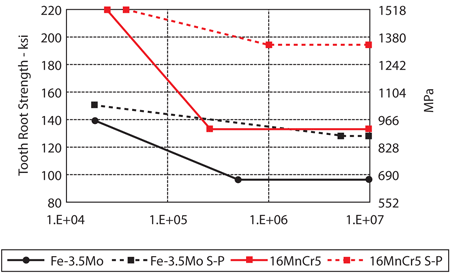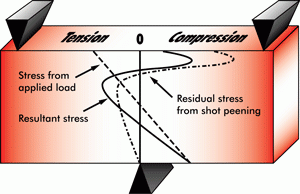Preparing Powder Metallurgy (PM) components for high performance applications
In order to penetrate markets that use critical components operating in highly stressed environments, the material fatigue performance needs to be fully optimised.
It is a well known fact that metal failures are caused by cracks that initiate at the surface in areas of high tensile stress concentration. The cracks grow as a result of cyclic stresses that are often far lower than the static design stress for the component.
The fatigue damage is cumulative and permanent, with ultimate failure occurring once cracks have propagated to a stage where the remaining section is unable to withstand the application of a single load.
Factors affecting fatigue life in PM components:
- Mean applied tensile stress
- Stress amplitude
- Material density
- Fatigue strength of material
- Component geometry
- Process induced residual tensile stresses
Tensile residual stresses that are introduced during post powder forming operations such as milling, turning or grinding sit close to the material surface and are effectively added to the operating stresses. These tensile residual stresses attempt to pull or tear the material apart accelerating crack propagation and reducing working life still further.
Extending fatigue life
Increasing the material density is probably the industry’s primary objective when trying to develop processes for highly stressed applications.
Another cost effective method that should be considered alongside improving material density is to carry out a controlled shot peening operation. The process involves firing high quality spherical media at the component surface in a strictly controlled manner.
The impacts produce spherical dimples in the material surface causing elastic plastic deformation. The overlapping dimples replace the harmful tensile stresses with a layer of beneficial compressive residual stress. The compressive layer helps to prevent the initiation and propagation of fatigue cracks by effectively reducing the applied load at the surface and sub surface. Surface densification also assists in the closing of surface porosity of PM components for sealing and other engineering applications.
Benefits of carrying out controlled shot peening on PM components
- Increased and more predictable working life
- Increased resistance to many fatigue failure modes
- Improved surface integrity
- Increased surface hardness on work hardening materials
- Isotropic surface finish
- Reduced component weight (less powder)
High density powder metal gears
Tooth root bending fatigue studies were performed using pulsator tests to compare a reference wrought gear steel to a 7.5 g/cm3 powder metallurgy gear. Both gears were 3.5 mm module consisting of 25 teeth and case hardened to 60 HRC. The wrought gear was a 16MnCr5 steel and the powdered metal gear was Fe-3.5Mo alloy content.
In Fig. 2 the powder metallurgy gear results are depicted with the black curves. The endurance limit improved ~ 35% with the addition of shot peening. The endurance limit improved from ~ 95 ksi (650 MPa) to ~ 128 ksi (880 MPa).

Fig. 2 Fatigue life curves comparing a reference (16MnCr5) wrought steel to a 7.5 g/cm3 powdered metal (Fe-3.5Mo) without shot peening
The endurance limit of the shot peened PM gear compares very closely with the non-peened 16MnCr5 material. Due to the significant cost savings of the powder metallurgy process, the shot peened PM gear may be a suitable replacement to the more expensive wrought steel gear. Shot peening was performed at 0.013” A (0.32 mm A) intensity for all samples [1].
Today, shot peening can be very accurately applied and controlled using the latest robotic technology to ensure that the shot stream is fired normal to the component surface even on components with complex geometry. A variety of media are available including carbon steel, stainless steel, glass and ceramic.
The selection of the shot peening parameters to match the material and application requirements is critical to the optimisation of material performance. Software such as the Metal Improvement Company’s Peenstress™ system can be used, together with the skill and expertise of an experienced shot peening organisation, to create an optimum peening specification for each individual application.
In some cases the fatigue life can be extended further by carrying out post peen isotropic superfinishing such as the Metal Improvement Company’s CASE™ process.
Shot peening has long been used to achieve significant fatigue-life improvements in wrought components. PM components also respond well to peening and it is hoped that the industry will broaden the use of this technology in order to gain new applications for critical highly stressed components.
Reference
[1] Strehl, R., 2001, “Load Capacity of Gears Made From High Strength Powder Metal Steel,” Doctorate Thesis Study, University of Aachen, Germany
News | Articles | Market reviews | Search directory | Subscribe to e-newsletter






